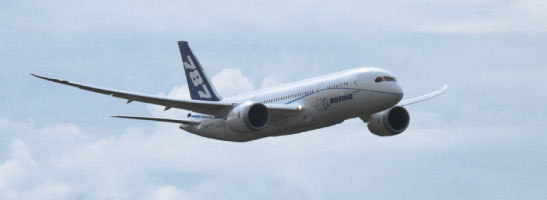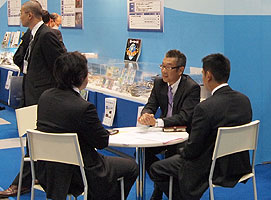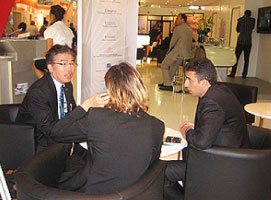Our history and purpose
Serving the industry
Along with environmental, robot and bullet train technologies, aerospace will be a major Japanese industry in the 21st century. A system spanning industry, academia and government supports research in this vital area. National and local government authorities, the Society of Japanese Aerospace Companies (SJAC), universities and other research institutions and organizations are all joining together to galvanize overseas aerospace business endeavors.
The Japan International Aerospace Exhibition 2012 (JA2012) is part of this push, and will make wide-ranging contributions to aerospace expansion.
Helping the Aircraft Manufacturing Sector Grow
In recent years, high-precision machinery, engineering and other Japanese aerospace technologies have earned solid reputations throughout the world. The United States' state-of-the-art planes use components developed entirely in Japan, and global demand for Japanese technology is steadily increasing. JA2012 provides a vital opportunity for exhibitors to let the world at large know about their unique technologies.
Helping Space Development Technologies Expand
Space development was once inextricably linked to the military development of the twin superpowers, America and Russia. But that age has passed, and Japan has joined the space race. As IT technologies advanced rapidly over the last 30 years, demand for observational satellites kept pace, particularly in communications, environmental monitoring, resource development, disaster prevention and other peaceful or industrial applications. This has in turn raised the bar for Japan’s space technologies. By providing business matching opportunities at the largest space exhibition in Asia, JA2012 will bolster Japanese space development.
Providing Opportunities
Demand for aircraft in Asia is sure to rise dramatically, especially for regional jets (medium-size passenger aircraft), airport infrastructure, and industries which support air transport.
Asian space business models have not yet caught up to those in Europe and North America, meaning the industry could still be hiding considerable growth potential. The success of Hayabusa served to showcase the excellence of Japanese space development technology and its production of related equipment, both of which have garnered considerable trust already. Businesses across the world will be keeping a close eye on this exhibition and on the Nagoya region, Asia’s largest production area.
Demand continues to grow for Japanese aerospace manufacturing and space development technologies. JA2012 has readied the largest business-to-business trade program in Asia to give professionals in these fields the opportunities they vitally need.
Matching the Right Businesses
The Japanese aerospace industry is full of small- to medium-sized companies that work day and night to manufacture precision components and develop new technologies. But despite the world-class reliability and creativity of their products, many of them struggle on the global market due to linguistic hurdles, difficulties surrounding product certification, and a reluctance to adopt IT-driven business methods.
In order to overcome these problems, JA2012 has established a business consultation system which features world business standards, and will host business talks open to all companies regardless of size or experience. One such event is the BCI business matching system already used at major air shows in America. The system will coordinate over 5,000 business consultations over the course of the exhibition. Translation and IT support will also be in place where necessary.



